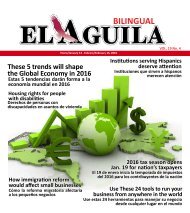El Aguila Magazine – August 17, 2016
Create successful ePaper yourself
Turn your PDF publications into a flip-book with our unique Google optimized e-Paper software.
<strong>El</strong> <strong>Aguila</strong> Agosto/Augost <strong>17</strong> - Septiembre/September 14, <strong>2016</strong><br />
IRS trabaja para ayudar a los contribuyentes afectados por<br />
cambios a los ITIN; las renovaciones comenzarán en octubre<br />
WASHINGTON— <strong>El</strong> Servicio<br />
de Impuestos Internos<br />
anunció hoy cambios<br />
importantes para ayudar a los<br />
contribuyentes a cumplir con las<br />
revisiones al programa del Número<br />
de Identificación Personal del<br />
Contribuyente (ITIN, por sus siglas<br />
en inglés) bajo una nueva ley. Los<br />
cambios requieren que algunos contribuyentes<br />
renueven su ITIN a partir<br />
de octubre.<br />
La nueva ley significará que los<br />
ITIN que no se han utilizado en una<br />
declaración federal de impuestos<br />
por lo menos una vez en los últimos<br />
WASHINGTON — The<br />
Internal Revenue Service<br />
today announced<br />
important changes to help taxpayers<br />
comply with revisions to the<br />
Individual Taxpayer Identification<br />
Number (ITIN) program made<br />
under a new law. The changes<br />
require some taxpayers to renew<br />
their ITINs beginning in October.<br />
The new law will mean ITINs that<br />
have not been used on a federal tax<br />
return at least once in the last three<br />
years will no longer be valid for<br />
use on a tax return unless renewed<br />
by the taxpayer. In addition, ITINs<br />
issued prior to 2013 that have been<br />
used on a federal tax return in the<br />
last three years will need to be renewed<br />
starting this fall, and the<br />
IRS is putting in place a rolling renewal<br />
schedule, described below,<br />
to assist taxpayers.<br />
If taxpayers have an expired ITIN<br />
and don’t renew before filing a tax<br />
return next year, they could face a<br />
refund delay and may be ineligible<br />
for certain tax credits, such as the<br />
Child Tax Credit and the American<br />
Opportunity Tax Credit, until<br />
the ITIN is renewed.<br />
“The ITIN program is critical to<br />
allow millions of people to meet<br />
their tax obligations,” said IRS<br />
Commissioner John Koskinen.<br />
“The IRS will be taking steps to<br />
help taxpayers with these changes,<br />
and we’re designing this effort to<br />
minimize the burden as much as<br />
possible. We will be working with<br />
partner groups on an outreach<br />
effort to share information about<br />
these changes to ensure people<br />
understand what they need to do<br />
in advance of next year’s tax season.”<br />
The ITIN changes are required<br />
by the Protecting Americans from<br />
tres años ya no serán válidos para su<br />
uso en una declaración de impuestos<br />
a menos que sean renovados por el<br />
contribuyente. Además, a partir de<br />
este otoño se deberán renovar los<br />
ITIN emitidos antes de 2013 que se<br />
hayan utilizado en una declaración<br />
federal de impuestos en los últimos<br />
tres años, y el IRS se encuentra en el<br />
proceso de establecer un horario de<br />
renovación por etapas, que se describe<br />
a continuación, para ayudar a los<br />
contribuyentes.<br />
Si los contribuyentes tienen un ITIN<br />
caducado y no lo renuevan antes de<br />
presentar una declaración de impues-<br />
IRS works to help taxpayers affected by ITIN<br />
changes; renewals begin in October<br />
Tax Hikes (PATH) Act enacted by<br />
Congress in December 2015. These<br />
provisions, along with new procedures<br />
to help taxpayers navigate<br />
these changes, are outlined in IRS<br />
Notice <strong>2016</strong>-48, which was released<br />
today.<br />
Who Has to Renew an ITIN<br />
The IRS emphasizes that no action<br />
is needed by ITIN holders if they<br />
don’t need to file a tax return next<br />
year. There are two key groups of<br />
ITIN holders who may need to renew<br />
an ITIN so it will be in effect<br />
for returns filed in 20<strong>17</strong>:<br />
•Unused ITINs. ITINs not used on<br />
a federal income tax return in the<br />
last three years (covering 2013,<br />
2014, or 2015) will no longer be valid<br />
to use on a tax return as of Jan.<br />
1, 20<strong>17</strong>. ITIN holders in this group<br />
who need to file a tax return next<br />
year will need to renew their ITINs.<br />
The renewal period begins Oct. 1,<br />
<strong>2016</strong>.<br />
•Expiring ITINs. ITINs issued before<br />
2013 will begin expiring this<br />
year, and taxpayers will need to<br />
renew them on a rolling basis. The<br />
first ITINs that will expire under<br />
this schedule are those with middle<br />
digits of 78 and 79 (Example: 9XX-<br />
78-XXXX).<br />
The renewal period for these ITINs<br />
begins Oct. 1, <strong>2016</strong>. The IRS will<br />
mail letters to this group of taxpayers<br />
starting in <strong>August</strong> to inform<br />
them of the need to renew their<br />
ITINs if they need to file a tax return<br />
and explain steps they need to<br />
take. The schedule for expiration<br />
and renewal of ITINs that do not<br />
have middle digits of 78 and 79 will<br />
be announced at a future date.<br />
How to Renew an ITIN<br />
Only ITIN holders who need to<br />
file a tax return need to renew their<br />
tos el año próximo, podrían enfrentarse<br />
a una demora en sus reembolsos y<br />
podrían no ser elegibles para ciertos<br />
créditos tributarios, tales como el Crédito<br />
Tributario por Hijos y el Crédito<br />
Tributario de la Oportunidad Americana,<br />
hasta que se renueve el ITIN.<br />
“<strong>El</strong> programa del ITIN es crítico para<br />
permitir que millones de personas<br />
cumplan con sus obligaciones de impuestos”,<br />
dijo el Comisionado del IRS<br />
John Koskinen. “<strong>El</strong> IRS tomará medidas<br />
para ayudar a los contribuyentes<br />
con estos cambios, y estamos diseñando<br />
estos esfuerzos para reducir al mínimo<br />
la carga tanto como sea posible.<br />
ITINs. Others do not need to take<br />
any action.<br />
Starting Oct. 1, <strong>2016</strong>, ITIN holders<br />
can begin renewing ITINs that are<br />
no longer in effect because of three<br />
years of nonuse or that have a middle<br />
digit of 78 or 79. To renew an ITIN,<br />
taxpayers must complete a Form<br />
W-7, Application for IRS Individual<br />
Taxpayer Identification Number,<br />
follow the instructions and include<br />
all information and documentation<br />
required. To reduce burden on taxpayers,<br />
the IRS will not require individuals<br />
renewing an ITIN to attach<br />
a tax return when submitting their<br />
Form W-7. Taxpayers are reminded<br />
to use the newest version of the Form<br />
W-7 available at the time of renewal<br />
which will be posted in September<br />
(Use version “Rev. 9-<strong>2016</strong>”).<br />
There are three methods taxpayers<br />
can use to submit their W-7 application<br />
package to renew their ITIN.<br />
They can:<br />
•Mail their Form W-7 — along with<br />
the original identification documents<br />
or certified copies by the agency that<br />
issued them — to the IRS address<br />
listed on the form (identification documents<br />
will be returned within 60<br />
days),<br />
•Use one of the many IRS authorized<br />
Certified Acceptance Agents or<br />
Acceptance Agents around the country,<br />
or<br />
•In advance, call and make an<br />
appointment at an IRS Taxpayer<br />
Assistance Center in lieu of mailing<br />
original identification documents to<br />
the IRS.<br />
For more information, visit the<br />
ITIN information page on IRS.gov.<br />
IMPUESTOS Y FINANZAS/TAX & FINANCE<br />
Trabajaremos con grupos de socios<br />
en un esfuerzo para compartir información<br />
acerca de estos cambios y<br />
asegurar que las personas entiendan<br />
lo que tienen que hacer antes de la<br />
próxima temporada de impuestos.”<br />
Los cambios en los ITIN son requeridos<br />
por la Ley de Protección a los<br />
Americanos de Alzas de Impuestos<br />
(PATH, por sus siglas en inglés) promulgada<br />
por el Congreso en diciembre<br />
de 2015. Estas disposiciones,<br />
junto con nuevos procedimientos<br />
para ayudar a los contribuyentes a<br />
navegar por estos cambios, se presentan<br />
en el aviso <strong>2016</strong>-48 (en inglés)<br />
del IRS, publicado hoy.<br />
Quién tiene que renovar un ITIN<br />
<strong>El</strong> IRS enfatiza que ninguna acción<br />
es necesaria por los titulares de ITIN<br />
si no necesitan presentar una declaración<br />
de impuestos el año próximo.<br />
Hay dos grupos principales de personas<br />
con ITIN que necesitan renovarlo<br />
para que esté en vigor para declaraciones<br />
presentadas en el año 20<strong>17</strong>:<br />
•ITIN sin uso. Los ITIN que no se<br />
han usado en una declaración federal<br />
de impuestos en los últimos tres años<br />
(2013, 2014 o 2015) no serán válidos<br />
en una declaración de impuestos<br />
a partir del 1 de enero de 20<strong>17</strong>. Las<br />
personas con un ITIN en este grupo<br />
que necesitan presentar una declaración<br />
de impuestos el año próximo<br />
tendrán que renovar sus ITIN. <strong>El</strong><br />
período de renovación comienza el 1<br />
de octubre de <strong>2016</strong>.<br />
•ITIN que expiran. Los ITIN emitidos<br />
antes de 2013 comenzarán a caducar<br />
este año, y los contribuyentes<br />
tendrán que renovarlos por turnos.<br />
Los primeros ITIN que vencerán<br />
bajo esta programación son los que<br />
tienen dígitos medios de 78 y 79<br />
(ejemplo: 9XX-78-XXXX). <strong>El</strong> período<br />
de renovación para estos ITIN<br />
comienza el 1 de octubre de <strong>2016</strong>.<br />
<strong>El</strong> IRS enviará cartas a este grupo<br />
de contribuyentes a partir de agosto<br />
para informarles de la necesidad de<br />
renovar su ITIN si necesitan presentar<br />
una declaración de impuestos<br />
y que explica los pasos a tomar. <strong>El</strong><br />
calendario de vencimiento y renovación<br />
de ITIN que no tienen dígitos<br />
13<br />
medios de 78 y 79 se anunciará en una<br />
fecha futura.<br />
Cómo renovar un ITIN<br />
Únicamente los titulares de ITIN que<br />
necesiten presentar una declaración de<br />
impuestos necesitan renovar su ITIN.<br />
Las demás personas no tendrán que<br />
realizar ninguna acción.<br />
A partir del 1 de octubre de <strong>2016</strong>, los<br />
titulares de ITIN pueden comenzar a<br />
renovar los ITIN que ya no son efectivos<br />
debido a tres años sin uso o los<br />
que tienen un dígito medio de 78 o 79.<br />
Para renovar un ITIN, los contribuyentes<br />
deben completa un formulario<br />
W-7, Solicitud de Número de Identificación<br />
Personal del Contribuyente del<br />
IRS, seguir las instrucciones e incluir<br />
toda la información y documentación<br />
requerida. Para reducir la carga a los<br />
contribuyentes, el IRS no requerirá<br />
que las personas que renueven un ITIN<br />
adjunten una declaración de impuestos<br />
al presentar su formulario W-7. Se recuerda<br />
a los contribuyentes a utilizar<br />
la versión más reciente disponible del<br />
formulario W-7 al momento de la renovación,<br />
que se publicará en septiembre<br />
(use la versión “Rev. 9-<strong>2016</strong>”).<br />
Hay tres métodos que los contribuyentes<br />
pueden usar para presentar su paquete<br />
de aplicación de W-7 para renovar<br />
su ITIN. Pueden:<br />
•Enviar su formulario W-7 por correo<br />
<strong>–</strong> junto con los documentos originales<br />
de identificación o copias certificadas<br />
por la agencia que los emitió, a la dirección<br />
del IRS indicada en el formulario<br />
(los documentos de identificación<br />
se devolverán dentro de un plazo de 60<br />
días),<br />
•Usar los servicios de los muchos<br />
Agentes Tramitadores Certificados autorizados<br />
por el IRS o Agentes Tramitadores<br />
a lo largo del país, o<br />
•Por adelantado, llamar y hacer una<br />
cita con un Centro de Ayuda al Contribuyente<br />
del IRS en lugar de enviar por<br />
correo al IRS sus documentos originales<br />
de identificación.<br />
Para más información, visite la página<br />
acerca de ITIN en IRS.gov.
















